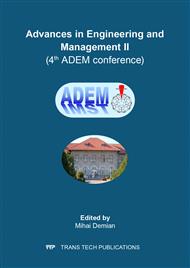[1]
ASM Handbook Vol.7 Powder metal technologies and applications,, ASM, Materials Park OH (1998).
Google Scholar
[2]
R.M. German, Powder metallurgy of iron and steel. MPIF, Princeton NJ (1996).
Google Scholar
[3]
A.Flodin, Powder metallurgy gears: Opportunities for enhancing automotive transmission design, Powder Metall. Review 3 No.1 (2014) 45-53.
Google Scholar
[4]
F.V. Lenel, Powder metallurgy – principles and applications. MPIF, Princeton NJ (1980).
Google Scholar
[5]
H.C. Neubing, G.Jangg, Sintering of aluminium parts – the state of the art, Metal Powder Report 42 (1987) pp.354-358.
Google Scholar
[6]
B.Lindqvist, Chromium alloyed PM steels - a new powder generation, Proc. EuroPM2001, Nice, EPMA, Shrewsbury (2001) Vol.1, pp.13-21.
Google Scholar
[7]
H.Danninger, C. Gierl, S. Kremel, G. Leitner, K. Jaenicke-Rößler, Y. Yu, Degassing and deoxidation processes during sintering of unalloyed and alloyed PM steels, Powder Metallurgy Progress Vol. 2, No.2 (2002) pp.125-140.
Google Scholar
[8]
M.Motooka, N.Kuroishi. A.Hara, N.Furukawa, Strength and ductility of Mn-Cr sintered steel, Metal Powder Report 38 (1983) No.11, p.3.
Google Scholar
[9]
H.Danninger, C.Gierl, New Alloying Systems for Ferrous Powder Metallurgy Precision Parts, Sci. Sintering 40 (2008) pp.33-46.
DOI: 10.2298/sos0801033d
Google Scholar
[10]
O.Bergman, L.Nyborg, Evaluation of sintered properties of PM steels based on Cr and Cr-Mn prealloyed powders, Powder Metall. Progress 10 No.1 (2010) pp.1-19.
Google Scholar
[11]
A.Šalak, Ferrous Powder Metallurgy, CISP, Cambridge UK (1995).
Google Scholar
[12]
B.Lindsley, S.Shah, G.Schluterman, J.Falleur, Mn-Containing Steels for High Performance PM Applications, Adv. Powder Metall. & Partic. Mater. - 2011 (Proc. PowderMet2011, San Francisco), compiled by I.E. Anderson, T.W. Pelletiers, MPIF, Princeton NJ (2011).
Google Scholar
[13]
J.Tengzelius, S.E. Grek, C.A. Blände, Limitations and possibilities in the utilization of Cr and Mn as alloying elements in high strength sintered steels, Modern Dev. in Powder Metall. 13 (1981) pp.159-182.
Google Scholar
[14]
A.Šalak, High strength sintered manganese steels, Modern Dev. in Powder Metall. 13 (1981) pp.183-201.
Google Scholar
[15]
A.Šalak, M.Selecka, R. Bures, Manganese in ferrous powder metallurgy, Powder Metall. Progress 1 No.1 (2001) pp.41-58.
Google Scholar
[16]
I.Karasuno, K.Koshiro, M.Umino, M.Ichidate, Some properties of oil atomized low alloy steel powders containing chromium, Horizons in PM (Proc. PM'86 Düsseldorf), W.A. Kaysser, W.J. Huppmann eds., Verlag Schmid, Freiburg (1986) Vol.1, pp.53-56.
Google Scholar
[17]
S.Unami, K.Ogura, S.Uenosono, Effect of C on the strength of sintered Cr-Mo alloyed steel powder compacts, Proc. PM'98 Powder Metallurgy World Congress Granada, EPMA, Shrewsbury (1998) Vol.3, pp.173-177.
DOI: 10.2497/jjspm.43.1106
Google Scholar
[18]
S.Berg, B.Maroli, Properties obtained by chromium-containing material, Adv. Powder Metall. and Partic. Mater. – 2002 (Proc. PM2002 Orlando, MPIF, Princeton NJ (2002) Part 8, p.1 (on CD).
Google Scholar
[19]
R. de Oro Calderon, E. Bernardo Quejido, M. Campos Gomez, C. Gierl-Mayer, H. Danninger, J.M. Torralba, Tailoring master alloys for liquid phase sintering: Effect of introducing oxidation-sensitive elements, Powder Metallurgy Vol. 59 (2016).
DOI: 10.1080/00325899.2016.1148897
Google Scholar
[20]
F.Castro, P.Ortiz, Study of gas-solid interactions during sintering of Cr-containing PM steels, Proc. EuroPM2003, Valencia, EPMA, Shrewsbury (2003) Vol.1, pp.261-267.
Google Scholar
[21]
H.Karlsson, L.Nyborg, S.Berg, Y.Yu: Surface product formation of chromium alloyed steel powder particles. Proc. EuroPM2001, Nice, EPMA, Shrewsbury (2001) Vol.1, pp.22-27.
Google Scholar
[22]
Hryha, C. Gierl, L. Nyborg, H. Danninger, E. Dudrova: Surface composition of the steel powders pre-alloyed with manganese,, Appl. Surf. Sci. Vol. 256 (2010) pp.3946-3961.
DOI: 10.1016/j.apsusc.2010.01.055
Google Scholar
[23]
C.Gierl-Mayer, H.Danninger: Dilatometry coupled with MS as instrument for process control in sintering of powder metallurgy steels. Powder Metall. Progress 15 (2015) No.1, pp.3-12.
DOI: 10.4028/www.scientific.net/msf.835.106
Google Scholar
[24]
A.R. Glassner: The Thermochemical Properties of the Oxides, Chlorides, and Fluorides to 2500°K. U.S. Atomic Energy Comm. Rep. ANL-5750, Washington D.C., (1957).
DOI: 10.2172/4348903
Google Scholar
[25]
S.Karamchedu, E.Hryha, L.Nyborg: Changes in the surface chemistry of chromium-alloyed powder metallurgical steel during delubrication and their impact on sintering. J. Mater. Processing Technol. 223 (2015) 171-185.
DOI: 10.1016/j.jmatprotec.2015.03.054
Google Scholar
[26]
Handbook of Chemistry and Physics, 67th Ed., CRC Press, Inc. Boca Raton FL, (1989).
Google Scholar
[27]
H. Danninger, A. Avakemian, C. Gierl-Mayer, M. Dlapka, M. Grafinger, Methane formation through substrate-atmosphere interaction during sintering of Si containing steels, Proc. Euro PM2014, EPMA, Shrewsbury UK (2014), Paper-Nr. EP14038.
Google Scholar
[28]
C.Gierl-Mayer, R. de Oro Calderon, H. Danninger, The role of oxygen transfer in sintering of low alloy steel powder compacts: A review of the internal getter, effect, JOM 68 (2016) No.3, pp.920-927.
DOI: 10.1007/s11837-016-1819-z
Google Scholar
[29]
H. Danninger, R. Pöttschacher, S. Bradac, A. Salak, J. Seyrkammer, Comparison of Mn, Cr and Mo alloyed sintered steels prepared from elemental powders, Powder Metall. 59 (2005) pp.23-32.
DOI: 10.1179/003258905x37567
Google Scholar
[30]
C. Gierl-Mayer, H. Danninger, R. de Oro Calderon, Methane Formation During Sintering Of PM Steels Alloyed With Chromium And/or Manganese, Proc. WorldPM2016 Congress and Exhibition, Hamburg, EPMA, Shrewsbury (2016) paper no. 3296841.
Google Scholar
[31]
R. de Oro Calderon, C. Gierl-Mayer, H. Danninger, Effects of H2 atmospheres on sintering of steels containing oxidation sensitive elements introduced through the master alloy route. Advances in Powder Metallurgy & Particulate Materials (2016).
DOI: 10.1007/s11837-017-2287-9
Google Scholar


